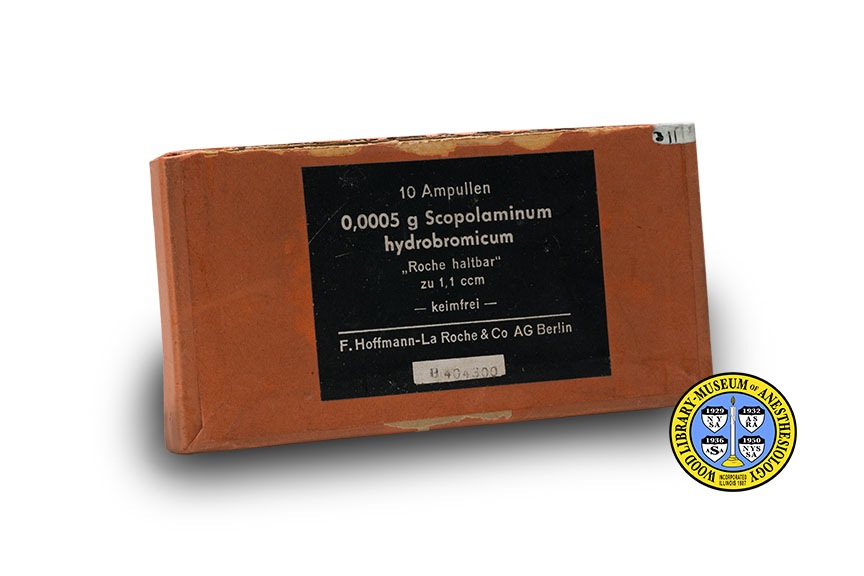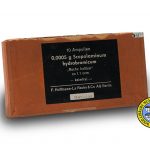Scopolamine
This German-manufactured package of scopolamine was found shortly after D-Day and the fall of Cherbourg, an occupied town and port in Northwest France. It was donated to the WLM by Captain Harry Meyer, M.D. (1919-1977). The letter that accompanied his donation included a particularly interesting report:
“ … We have just finished a tough stand – three weeks, day and night. I am Chief of Anesthesia for this hospital, and during this stretch gave about every type of anesthetic in the book. I cannot tell you the total figures, but here are the percentages: Pentothal, 67.26%; Local (Infiltration, Field, Block) 25.16%; Inhalation, 4.64%; Combined Pentothal, 1.78%; Spinal 1.16%. Also 15 lumbar and cervicothoracic sympathetic blocks. Most of the inhalations were intratracheal.”
Used as a medication and poison since ancient times, scopolamine is a compound found in a number of plants, including henbane and mandrake. Its varied effects can include sedation, dry mouth, and amnesia.
In the early 20th century, physicians started to administer scopolamine before anesthesia and surgery to minimize secretions and provide sedation. It was also part of a popular treatment for labor pain called, “twilight sleep,” which was introduced around 1907. Scopolamine was combined with morphine and administered in carefully controlled doses. Twilight sleep deeply sedated the mother and prevented her from forming memories of the childbirth experience. Scopolamine is sometimes used today to treat motion sickness, nausea and vomiting.
Catalog Record: Scopolamine
Access Key: almk
Accession No.: 311
Title: Scopolaminum hydrobromicum / F. Hoffmann-La Roche & Co AG.
Corporate Author: F. Hoffmann-La Roche & Co AG.
Title variation: Alt Title
Title: Scopolamine.
Publisher: Berlin : F. Hoffmann-La Roche & Co AG, [between 1940 and 1944].
Physical Descript: 1 drug package : paper and paperboard ; 2 x 13 x 6.5 cm.
Subject: Drug Packaging.
Subject: Scopolamine Hydrobromide.
Note Type: General
Notes: The date range for the possible year of manufacture of this package of
Scopolaminum hydrobromicum is based on its provenance – abandoned by
retreating German soldiers and collected by Captain Marry Meyer in July of
1944. The date range could change if documentation indicates that it should
be corrected.
Note Type: General
Notes: Caton D. The history of obstetric anesthesia. In: Chestnut DH, Polley LS,
Tsen LC, Wong CA. Chestnut’s Obstetric Anesthesia: Principles and Practice.
4th ed. Philadelphia: Mosby/Elsevier; 2009:3-14.
Note Type: General
Notes: Everett N, Gabra M. The pharmacology of medieval sedatives: the “Great Rest”
of the Antidotarium Nicolai. J Ethnopharmacol. 2014;155(1):443-449.
Note Type: Citation
Notes: Gifts to the museum. Newsl Am Soc Anesthetists. September, 1944;8(9):1,3.
Note Type: Citation
Notes: Harry Meyer donor file. Located at: Located at: Wood Library-Museum of
Anesthesiology, Schaumburg, Illinois.
Note Type: Citation
Notes: Jones FA. Herbs — useful plants. Their role in history and today. Eur J
Gastroenterol Hepatol. 1996;8(12):1227-1231.
Note Type: Physical Description
Notes: One box for 10 ampules of scopolamine; The ampules are no longer in the box;
The box is covered in orange paper and has a black label with white
lettering; The label is marked with the following text: “10 Ampullen [new
line] 0,0005 g Scopolaminum [new line] hydrobromicum [new line] “Roche
haltbar” [new line] zu 1,1 ccm [new line] — keimfrei — [new line] F.
Hoffmann-La Roche & Co AG Berlin”; Below the text on the label is a small
white sticker marked with the following: “B404300”; Inside the box are 10
narrow compartments for the ampules; A strip of cotton fabric lines all of
the compartments; Also in the box is a small meal ampule file.
Note Type: Reproduction
Notes: Photographed by Mr. Steve Donisch November 12, 2014.
Note Type: Acquisition
Notes: Donated to the WLM by Captain Harry Meyer, MD.
Note Type: Historical
Notes: This German-manufactured package of scopolamine was captured in France during
World War II, shortly after D-Day. Anesthesiologist Captain Harry Meyer, MD,
(1919-1977) donated it and a number of other items that were abandoned by
German forces. The letter that accompanied his donation included a
particularly interesting report:
“I am sending you today a variety of anesthetic medicaments which were
captured in the fall of Cherbourg, as I thought they would be of interest to
you. We have just finished a tough stand – three weeks, day and night. I am
Chief of Anesthesia for this hospital, and during this stretch gave about
every type of anesthetic in the book. I cannot tell you the total figures,
but here are the percentages: Pentothal, 67.26%; Local (Infiltration, Field,
Block) 25.16%; Inhalation, 4.64%; Combined Pentothal, 1.78%; Spinal 1.16%.
Also 15 lumbar and cervicothoracic sympathetic blocks. Most of the
inhalations were intratracheal.”
Before and after his service with the 45th Evacuation Hospital, Dr. Meyer
practiced at Yonkers Professional Hospital. He was a member of the American
Society of Anesthetiologists from 1937-1974.
Scopolamine is a compound found in a number of plants, including henbane and
mandrake. It has been used as a medication and poison since ancient times.
Scopolamine’s varied effects can include sedation, dry mouth, and amnesia.
In the early 20th century, physicians started to administer scopolamine
before anesthesia and surgery. It was also part of a popular treatment for
labor pain called, “twilight sleep.” Introduced around 1907, scopolamine was
combined with morphine and administered in carefully controlled doses.
Twilight sleep deeply sedated the mother and prevented her from forming
memories of the childbirth experience. Scopolamine is still used today to
treat motion sickness, nausea and vomiting.
Note Type: Publication
Notes: Defalque RJ, Wright AJ. Scophedal (SEE): was it a fad or a miracle drug? Bull
Anesth History. October, 2003;21(4):12-14. https://ahahq.
org/Bulletin/October_2003.pdf. Accessed January 26, 2015.
Note Type: Publication
Notes: Winter A. The making of “truth serum,” 1920-1940. Bull Hist Med.
2005;79(3):500-533.
Note Type: Exhibition
Notes: Exhibited at the National World War II Museum in New Orleans, October, 2014.


